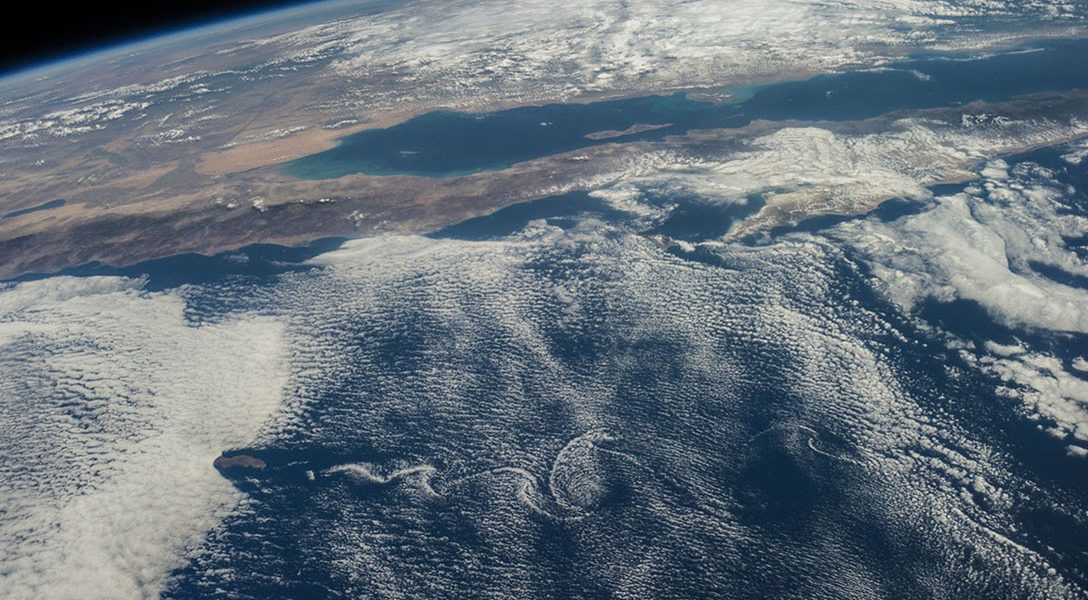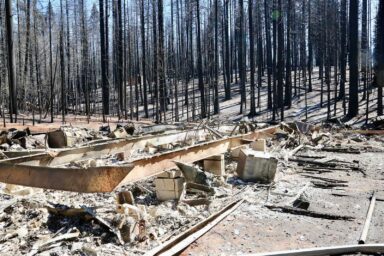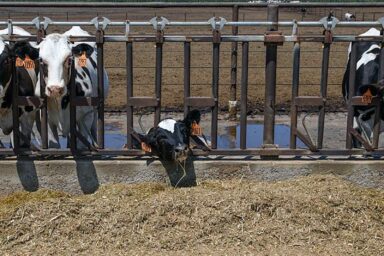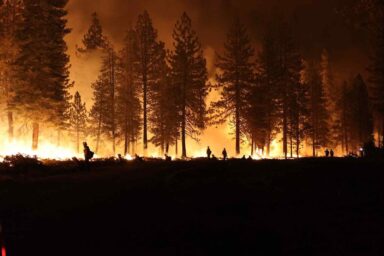A look at the cutting-edge technology that may enable us to actually confront climate change.
Today, we can’t even agree on the basics of a disease that has killed almost 130,000 Americans and almost half a million worldwide. The odds of us agreeing on what to do about climate change seem remote at best.
In his new book Hacking Planet Earth, and in this WhoWhatWhy podcast, Thomas Kostigen — who founded the Climate Survivalist column for USA Today — details some of the forward-thinking fixes for our climate that go beyond just the mitigation of carbon emission and waste.
He talks about scientists, technologists, entrepreneurs, and visionaries who are looking for whole new ways to solve the problems of global warming — even things as crazy sounding as giant parasols floating above the earth, underground cities, vertical farms, and lasers shooting into clouds to coax water, to name a few.
Despite the potentially devastating consequences of climate change that lie ahead, he is actually optimistic, even as he says “Reduce, Reuse, Recycle” is not going to be enough. All portend a future based on what Kostigen says is a foundation for action: invent, pioneer — and disrupt.



Click HERE to Download Mp3
Full Text Transcript:
As a service to our readers, we provide transcripts with our podcasts. We try to ensure that these transcripts do not include errors. However, due to time constraints, we are not always able to proofread them as closely as we would like. Should you spot any errors, we’d be grateful if you would notify us.
| Jeff Schechtman: | Welcome to the WhoWhatWhy Podcast. I’m your host, Jeff Schechtman.
Someone once said that the only way to predict the future is to invent it. It may very well be that invention is the only way we can begin to seriously address climate change, as we march headlong toward a tipping point from which the consequences may be irreversible. Like it or not, the current pandemic will divert money at every level, along with resources and energy, away from dealing forcefully with our next oncoming threat. Therefore, it may only be by virtue of technology, invention, and the imagination of entrepreneurs that we can save ourselves. As a society we seem to be either incapable or unwilling to rapidly make the required changes, but maybe as some see things as they might be and ask why not, we can develop a temporary vaccine for our environment that just might change our collective future. |
| Jeff Schechtman: | This is at the heart of my conversation with Thomas Kostigen. Thomas Kostigen is an award-winning New York Times bestselling author and journalist. He founded the Climate Survivalist column for USA Today and has written about climate and environmental issues for numerous publications. His previous books include The Green Book, The Green Blue Book, and his latest, Hacking Planet Earth. It’s an exploration of the cutting-edge technology that might enable us to confront climate change. It is my pleasure to welcome Thomas Kostigen to the WhoWhatWhy Podcast. Thomas, thanks so much for joining us. |
| Thomas Kostigen: | Thanks for having me. |
| Jeff Schechtman: | First of all, explain what geoengineering is specifically. |
| Thomas Kostigen: | Sure. The technical definition is the mass scale artificial intervention of the environment and the manipulation of the environmental process that affects the earth’s climate, in an attempt to counteract the effects of global warming. In short, it’s us doing nature’s work for her artificially. |
| Jeff Schechtman: | Is there a danger that if we rely too much on our own ability to innovate, if we rely on, or think about, technologies that might not even exist yet as being the solution to some of the problems we face, that it takes the pressure off of doing the things we really still need to do in order to protect the planet? |
| Thomas Kostigen: | You know, I had originally titled the book Frankenplanet, because I wanted to take a look at that side of things. And when I started to get into it, I realized this is a very hopeful message and that we have a lot of solutions that can change things for the better. And when you look at what you’re describing, the moral hazard of things where people feel like, “Okay, I don’t have to worry about smoking,” for instance, “because there’ll be a cure for lung cancer in the future,” I feel like that’s a bad bet. |
| Thomas Kostigen: | We need to have both. We need to have prevention, which is what we’ve been doing, mitigation methods like turning off the lights when you leave a room, turning down the thermostat, stopping your car from idling, relying less on fossil fuels as we transition to alternative sources. But at the same time, we also need plan B possibilities, much like we’re seeing play out in the healthcare world today. We’re washing our hands. We’re doing social distancing. We’re taking those prevention methods and measures, but we also need treatments. We also need vaccines. And that’s what I talk about in Hacking Planet Earth, vaccines for the planet. |
| Jeff Schechtman: | When you look at some of these measures, some of these innovations that you talk about, to what extent are they realistic at this point and to what degree are some of them fanciful and things that we might be striving for? |
| Thomas Kostigen: | Sure. Let’s start with the practical. Very simple. There’s two common forms of geoengineering, solar engineering and carbon engineering. Solar engineering on a practical measure can be painting blacktops white. Lighter surfaces better reflect the sun, sends that energy back up into the atmosphere, into outer space, and therefore cooling the area around us. Much like in the summertime, you wear a black t-shirt versus a white t-shirt. You’re going to be a lot warmer in the black t-shirt because you’re holding that. That’s a very practical ways to enact on a cool roofs or cool roads methodology, or cool alleys. And there’s a lot of very, very sophisticated materials that you can cover those black surfaces with. All the way to the fanciful, which is a space parasol that will hover in outer space and deflect the sun before it even gets to earth. |
| Thomas Kostigen: | So we have degrees of this, and we have to take a look at all of those and where it’s best put for our minds and our dollars in order to lower temperatures on the planet. Same thing with carbon engineering. There are very, very simple ways that are out there today that can lower carbon in the atmosphere, keeping our soils healthy, for example. That keeps more carbon in the ground if we don’t degrade soil, if we just use smartly what we have. That keeps more carbon out of the atmosphere. All the way to giant machines that will suck carbon out of the atmosphere for us. And so we have a number of different degrees on a lot of these technologies. We just have to take a look at the entire menu and then decide which ones are best for us, but we need to have those options in front of us today, in my point of view. |
| Jeff Schechtman: | When we look at it in terms of cost, how practical is some of this? |
| Thomas Kostigen: | When you look at the fact that economists have predicted by mid-century the ramifications of climate change will cost the world about 3% of global GDP, trillions and trillions and trillions of dollars, and the cost today will be about five cents on those dollars. So we’re getting a good value for what we can do today. Just like in anything, if you start today. In insurance, if you pay your insurance premium today and then God forbid you get into an accident later and you don’t have insurance, it’s a lot better to have paid your insurance today. So if we look at this as a giant insurance policy, we’d be getting a good deal for our dollar. |
| Jeff Schechtman: | Talk a little bit about the cutting edge of this and, if there is any specific place or framework, where this research is going on into some of these things. |
| Thomas Kostigen: | Absolutely. It’s being done all over the world, really, and we have variants of it. In China, there’s a weather modification agency that employs 37,000 people. That’s looking at ways to manipulate the weather in order to create more precipitation in certain areas or the opposite, create dry conditions in other areas. Also here in the United States, we have innovation centers on different campuses. Arizona State University has several different technologies in this space, so at the campus level and the university level. |
| Thomas Kostigen: | We also have the private sector. There’s about $2 billion worth of venture capital flowing in the carbon tech quote-unquote space today. That’s creating different technologies that can do what I was talking about before, which is draw carbon out of the atmosphere and create products out of it, or have it increase agriculture. |
| Thomas Kostigen: | So there’s different ways across the board. The governments have not really gotten involved in this. Policy has not followed the geoengineering bouncing ball. So we need to create a bridge, again in my point of view, between the private sector and the science community in order to fund a lot of these possibilities or at least fund the research of a lot of these possibilities. And that’s what’s lacking today. |
| Jeff Schechtman: | And why is it lacking? Why are not more individuals or companies stepping up? |
| Thomas Kostigen: | Twofold. One is that lackadaisical sensibility that it’s a threat, but it’s 50 years from now. Let’s put our dollars elsewhere that will get us a return on investment tomorrow and without seeing those possibilities. So we need to change that, and that is increasingly changing. We have the CEO of BlackRock, the largest asset manager in the world, saying that they are no longer going to invest in companies that ignore climate change. That’s a big, big statement for companies to say whoa, we’re going to change our thinking around this, think of it as a threat, think of it as something that is going to affect business. And again, we’re seeing that play out in the public health space today. |
| Thomas Kostigen: | And then secondly, how do we get the word out about these technologies? You can’t invest in something, you can’t get behind something, you can’t promote something, or you can’t raise awareness about something if you don’t know what it is. So we need the science community to, I believe, get the messaging right, get the word out that a lot of technologies exist and here are the possibilities for the future of the world. And that’s a really important thing for us to do today. |
| Jeff Schechtman: | Is this a moving target? Is there a danger that by the time some of these things come online or become practical, or at least reach some kind of scale, that the problem will have fundamentally changed? |
| Thomas Kostigen: | Like any variable in the environment, any variable in the health sector, it is a moving target. So in order for us to capture more of this, we need to start today. And that’s the problem. We have often waited too long, and in my view, we have waited too long as things increase that threat. Unless we start today, we’re going to be behind the whole way. That’s what’s been the problem. And we do have technologies that are being used today on a smaller scale and they can’t be ramped up, and that’s a factor of dollars and capital. |
| Thomas Kostigen: | Congress just allocated about $4 million, not a lot but a little bit, to look at plan B possibilities, with the other engineering and government speak. And there’s a larger chunk to investigate a lot of these possibilities in the energy innovation bill, which is stalled, of course, right now in the Senate. But there are a lot of people looking at these possibilities, both at that level of funding, and in the private sector we’re starting to see a lot of people come around and say okay, let’s get behind a lot of these things, because we see the effects happening today. We see more extreme weather. We see more extreme events. We have to start to ramp up our defenses. |
| Jeff Schechtman: | Talk a little bit about some of the things that are happening in the realm of agriculture. You touched on that a little bit before. |
| Thomas Kostigen: | Yeah, there’s some fascinating things going on in the food chain, from creating completely artificial meals for us. Biolent , echoing the Soylent Green movie, if you remember that way-back-when with Charlton Heston. And a company came out and created a completely artificial meal source for us, that has everything you need in one meal. So that’s one way to go with this. Again, not the same source that was promoted in the movie in the final scene, but I won’t give it away, but a much healthier way, ostensibly, what they claim. |
| Thomas Kostigen: | And then there’s genetically modified animals, particularly modified salmon that are grown in a tube that are for commercial consumption right now. So that’s another way to go, to promote and facilitate the breeding of certain animals. And that goes through genetic modification, and that goes all the way down to the seed as well, genetically modified seeds. |
| Thomas Kostigen: | And then there are different methodologies for growing that are more sophisticated. We have artificial intelligence and drones and ways of creating smart soils using nanotechnology, so we can measure just how much water we need or just how much sunlight, and what are the perfect conditions to increase yield? And then we have drones that will go around and pick the fruit off the trees, for example, at exactly the right time so they stay the freshest in the store. So we have a lot of technology that we can do in the agriculture side. |
| Thomas Kostigen: | And then there’s simply a way of just using less land. Vertical farming is a fast-growing field, because you can control the conditions when you have indoor vertical farms. So there is a number of different ways that we’re looking at changing the food supply, and again, livestock are a big impact on the planet and climate change, not only because you have to clear forests to raise livestock. So that that’s one factor. And then the methane, of course, that’s created by the animals is another factor. And there’s a group that now is taking the cells of certain meats and skipping the raising of livestock, so you can go right from lab to a patty on your plate, if you will, without having to raise the animal, and get the exact same type of nutrition and DNA, let’s call it, that you can consume. |
| Jeff Schechtman: | To what extent is all of this happening globally? Are there particular countries that are better at certain parts of this? As we look at the whole global picture today, how does that relate to what we’ve been talking about? |
| Thomas Kostigen: | I think every country, every developed country I should say, is looking for ways that they can service their population better. And that’s what we’re talking about at the end of the day here, how can we service things better? And smart cities are popping up all over the world, from China to the Middle East to Europe to even here in the United States and into Canada. And when you look at the growth of smart cities, which really means relying on technology, artificial intelligence, et cetera to create efficiencies, you have autonomous driving that can be baked into that, you have sensors that can be on cars or bikes. |
| Thomas Kostigen: | And just a small anecdote here. I was in Aars in Denmark, and they have a technology there where there’s sensors on your bike. So when you approach a traffic light, the lights turn green. It’s really user friendly from a mobility standpoint, encouraging walking, keeping things a little closer together, encouraging greenery inside a city. So there’s a lot of different approaches there. |
| Thomas Kostigen: | The cutting edge of this, a lot of this is coming out of the Middle East, places like the United Arab Emirates. Saudi Arabia has a place called Neom, which is going to be the city of the future, they claim, with all sorts of these programs that we talked about, solar engineering, cool roofs, cool roads, autonomous engineering, all that stuff, autonomous driving. So we have a lot of things that we can use, and they’re being developed all over the world. Hopefully, we’ll embrace them and create a better planet and climate for all of us. |
| Jeff Schechtman: | Do you have a concern at this point that because the pandemic crisis that we’re going through now is affecting those cities, those places with greater density, that there’s going to be a reaction from this, which really is anti-density and pro-sprawl? And that from a climate perspective, it could be disastrous? |
| Thomas Kostigen: | You know, I think that there is an anti-density movement happening today, and I think that we’re looking at ways with autonomous driving, for example, that will enable us to better commute. That’s what autonomous driving really is at the end of the day. It’s a way for us to have someone else take us to places more efficiently, and it’s a way for us to live in the suburbs without having to worry about congestion inside cities. And I think that’s the biggest thing. We often think about it as just the facility for us to get around easily without having to drive ourselves, but there’s a whole different way of approaching it. And that’s what I think autonomous driving is going to do. And you combine that with artificial intelligence for efficiencies, and I think that’s the biggest anti-congestion movement to my mind. |
| Jeff Schechtman: | What, if anything, are the resistance points to the kind of innovation that we’ve been talking about? Is it just money or are there other attitudes and things out there that create problems? |
| Thomas Kostigen: | Yes, there’s a couple of different things. There’s attitudinal, which is on the left, we have a lot of people saying, well, we can’t come up with a lot of these solutions, because then people just won’t do anything in their everyday life. We’ll stop minding our carbon footprints. We’ll just be reckless with what we do in our everyday lives. And so that’s an attitudinal resistance on the left. And on the right, of course, there is the idea that climate change doesn’t exist on the far right, so why do we have to even come up with any of these approaches to begin with? So attitudinally, we have from the left and from the right. |
| Thomas Kostigen: | And then financially, we have not put together a packet of capital that will engender or foster these technologies to scale. And that’s a big word, to scale, to make a difference. And so we have a couple different forces economically and attitudinally that we have to battle in order to create awareness and in order to have these programs be put into place and have them be practical solutions for us. |
| Jeff Schechtman: | Thomas Kostigen. Thomas, I thank you so much for spending time with us here on the WhoWhatWhy Podcast. |
| Thomas Kostigen: | Thanks for having me. |
| Jeff Schechtman: | Thank you. And thank you for listening and for joining us here on Radio WhoWhatWhy. I hope you join us next week for another Radio WhoWhatWhy Podcast. I’m Jeff Schechtman. If you liked this podcast, please feel free to share and help others find it by rating and reviewing it on iTunes. You can also support this podcast and all the work we do by going to whowhatwhy.org/donate. |
Related front page panorama photo credit: Adapted by WhoWhatWhy from GPA Photo Archive / Flickr (CC BY-NC 2.0)



